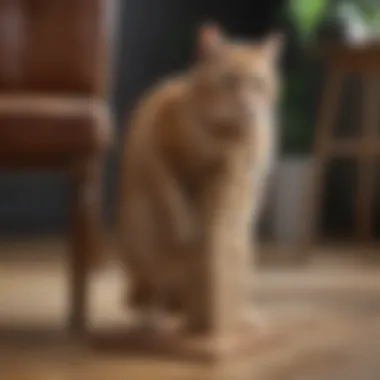Effective Strategies to Stop Cat Scratching Your Chair


Intro
Cats are fascinating creatures. Their behavior often puzzles their owners, especially when it comes to scratching furniture. Understanding why cats scratch is crucial. Scratching helps them maintain their claws, mark territory, and stretch their muscles. However, this instinct can lead to damage in your home. This article will provide insights and strategies to help you manage this behavior.
Throughout this guide, we will cover various aspects of cat care that are essential in addressing scratching issues. We will highlight preventative measures, behavioral training techniques, and engaging activities tailored to the needs of both cats and their owners. Whether you're a first-time pet owner or a seasoned cat lover, you will find valuable tips and resources to create a balanced and harmonious environment for your feline friend.
Pet Care and Grooming
Taking care of your cat encompasses many factors, including grooming. Regular grooming not only keeps your cat looking its best but also plays a vital role in managing their scratching behavior.
Importance of Regular Care
Regular grooming is crucial for sustaining your cat's well-being. It helps remove loose fur, dirt, and debris. Moreover, this process can prevent hairballs, which may lead to health issues. Regularly brushing your cat also encourages a stronger bond between you and your pet. Familiarity with touch can eventually help during other care routines, like trimming nails.
Grooming Techniques by Pet Type
Different cat breeds may require various grooming techniques. For long-haired breeds like Persians or Maine Coons, daily brushing is essential to avoid mats. Short-haired breeds, such as Siamese, may need less frequent grooming, perhaps once a week.
Tools and Products Recommendations
Investing in the right grooming tools can simplify the process. Here are some suggestions:
- Slicker brushes: Great for removing loose hair and preventing mats.
- Flea combs: Effective for detecting fleas and maintaining cleanliness.
- Nail clippers: Essential for managing sharp claws.
These tools can make grooming easier and more efficient.
Seasonal Care Tips
Seasonal changes can affect grooming needs. During shedding seasons, more frequent brushing is necessary. Winter may require additional attention to remove moisture or dirt from fur. Observing changes in your cat's coat will guide you on how often to groom.
Health and Nutrition
A cat's health and nutrition are intertwined significantly with their behavior. Providing a balanced diet is essential for their overall wellbeing.
Understanding Pet Nutrition
Cats are obligate carnivores. Their diet should consist primarily of high-quality protein. The right balance of nutrients will support muscle health and energy levels. Dry kibble and wet food both have benefits, and many owners opt for a combination to offer variety.
Common Health Issues by Species
Cats can face numerous health problems. Some common issues include obesity, dental disease, and urinary tract issues. Regular vet check-ups help monitor these conditions and provide actionable guidance.
Preventive Care and Regular Check-Ups
Taking your cat to the vet annually for routine check-ups is advisable. Regular assessments can help detect health problems before they worsen. Vaccinations and parasite control should be maintained to ensure a healthy lifestyle.
Food and Dietary Advice
It’s important to choose high-quality cat food. Read the labels. Look for named meat sources as the primary ingredient. Consult your vet for specific dietary recommendations tailored to your cat’s age, breed, and health needs.
Behavioral Training
Training your cat can significantly reduce unwanted behaviors. Understanding behavioral training is vital in handling scratching.
Basics of Positive Reinforcement
Positive reinforcement involves rewarding desirable behaviors. When your cat uses scratching posts instead of your furniture, provide praise or treats immediately.
Training Techniques Users Can Apply
Introduce scratching posts at various locations. Forcing your cat onto a post is ineffective. Instead, encourage them by rubbing catnip on the post or using toys nearby to create interest.
Managing Behavioral Issues
If scratching persists, it may be essential to reassess your cat's environment. Stress and boredom can lead to destructive behavior. Identify potential triggers and address them.


Importance of Socialization
Socializing your cat can mitigate anxiety. Expose your cat to new people, pets, and experiences gradually. This prevents fear-based behaviors, including scratching.
Engaging Activities and Enrichment
Keeping your cat engaged can reduce scratching. Cats thrive on mental and physical stimulation.
Fun Games to Play with Your Pet
Interactive playtime can divert attention from furniture. Using feather wands or laser pointers can stimulate predatory instincts.
DIY Toys and Activities
Creating DIY toys from household items can enhance your cat's play. For instance, use crumpled paper or cardboard boxes to create an engaging play environment.
Importance of Mental Stimulation
Puzzle toys that dispense treats can challenge your cat mentally. These toys encourage exploration and problem-solving skills.
Outdoor Adventures and Exploration
If safe, consider a leash for outdoor walks. Cats can observe the world and burn energy, reducing destructive behaviors at home.
Resources and Community Engagement
Numerous resources exist for cat owners to learn more and connect with others.
Recommended Books and Websites
- **
Understanding Why Cats Scratch
Understanding why cats scratch is essential for addressing the problem of damaged furniture. This knowledge gives pet owners insights, enabling them to implement effective strategies. It is crucial to comprehend the driving forces behind this behavior. Recognizing these factors not only aids in preservation of furniture but also ensures the emotional and physical well-being of the cat. This article discusses natural instincts, territory management, grooming needs, and factors that contribute to stress and anxiety in cats.
Natural Instincts and Scratching
Cats possess intrinsic instincts to scratch. This behavior serves several functions that relate to their natural evolutionary traits. Scratching helps cats maintain healthy claws by shedding old layers of their claws. Furthermore, it stretches muscles, promoting physical health and mobility. Acknowledging these instincts allows owners to provide suitable alternatives while preserving beloved furniture. They will have a better understanding about the necessity of scratching as a natural behavior.
Territorial Marking
Cats are territorial creatures. They use scratching as method to establish ownership of their domain. By marking surfaces with scent glands located in their paws, cats communicate their presence to others. When cats scratch chairs, they might be asserting dominance or marking their territory. Understanding this aspect can shape how owners react to scratching. Rather than viewing it as misbehavior, recognizing it as instinctual will foster a more constructive response toward their pet's actions.
Grooming and Nail Maintenance
Grooming is an essential process for cats. Scratching plays an important role in keeping their claws healthy and functional. Overgrown claws can cause pain or injury, making it crucial for cats to have the opportunity to scratch. Providing designated scratching areas allows owners to support their cat's grooming needs. This not only encourages acceptable scratching behavior but also breaks the habit of targeting the furniture.
Stress and Anxiety Factors
Stress and anxiety can trigger undesirable behavior in cats, including excessive scratching. Various changes in their environment, such as new pets or moving homes, can elevate stress levels significantly. In this context, scratching may serve as a coping mechanism. It is vital for owners to observe any shifts in their cat's behavior and address the underlying stressors. Creating a stable and calm environment reduces anxiety, potentially diminishing unwanted scratching behavior.
Assessing Your Furniture and Environment
Understanding your furniture and the environment is critical in tackling the problem of cat scratching. This process involves evaluating your space and the items within it to identify the factors that may be attracting your cat to scratch at specific areas, like your cherished chairs. Recognizing these elements allows for a tailored approach in mitigating scratching behavior.
Making assessments leads to several key benefits:
- Realizing Vulnerabilities: By pinpointing which areas and materials are susceptible to scratching, you can prioritize your protective measures effectively.
- Improving Cat Comfort: An optimized environment will not only protect your furniture but also cater to your cat's natural behaviors. This balance is essential.
- Reducing Stress: A thorough evaluation can help in determining if certain furniture arrangements or materials are causing stress or anxiety for your cat, leading to destructive behaviors.
In this context, two main areas warrant careful scrutiny: identifying high-risk areas around your home and evaluating the material selection of your furniture.
Identifying High-Risk Areas
Not every corner of your home is equally appealing for a cat to scratch. Some spots become high-risk areas due to their features. Consider the following factors:
- Proximity to Cat Stations: Areas near scratching posts, beds, or litter boxes are more attractive for scratching.
- Interior Design and Layout: Open spaces allow your cat to navigate freely and may lead to scratching in conspicuous areas.
- Furniture Height and Type: Low furniture, like ottomans or armchairs, can be prime targets for scratching.


Identify these high-risk areas by observing your cat’s behavior. Does your cat gravitate towards certain chairs or corners? Understanding these patterns is essential in preparing a strategy.
Material Selection and Vulnerability
The choice of materials in your furniture significantly influences its susceptibility to cat scratching. Several considerations come into play:
- Soft Fabrics versus Hard Surfaces: Cats tend to favor soft fabrics where they can sink their claws in. Materials like velvet or cotton will be more inviting than harder surfaces like leather or wood.
- Grain Orientation: Natural wood can often draw your cat in. Some woods with distinct grain patterns may also entice excited scratching.
- Durability and Repairability: Choose materials that are durable yet easy to repair. Some fabrics may be more forgiving than others when it comes to scratches.
Being informed on material choice not only helps in preventing damage to furniture but also aids in the overall aesthetic of your living space. Considering both functionality and appearance will help you achieve a harmonious balance between your furniture's integrity and your cat’s instincts.
Establishing Preventive Measures
Establishing preventive measures is crucial in addressing the issue of cats scratching furniture, especially chairs. Understanding the motivations behind this behavior enables cat owners to implement strategies that work to both deter scratching and satisfy the cat's natural instincts. Preventive measures can create an environment that reduces the likelihood of destructive scratching, protecting valuable furniture and ensuring a harmonious coexistence with feline companions.
Implementing such measures early can save both time and effort in managing scratching behavior. Moreover, these strategies can often enhance the overall living space for both pets and their owners. Essential aspects to consider include the types of furniture protectors and the methods of deterrence available to modify cat behavior effectively.
Using Furniture Protectors
Furniture protectors serve as a practical first line of defense against cat scratching. These items come in various forms, designed specifically to guard furniture from the sharp claws of cats. They can be both functional and aesthetically pleasing, ensuring their presence does not detract from the home’s decor.
Common types of furniture protectors include:
- Adhesive strips or pads: These can be placed on critical areas of chairs or couches where cats typically scratch. The sticky texture discourages cats from engaging with these surfaces.
- Scat mats: These are specially designed mats that deliver a harmless static pulse when a cat steps on them, encouraging the animal to avoid the area.
- Covers and slipcovers: Opting for slipcovers or protective covers can shield valuable fabrics from claws while allowing a simple change in appearance. They can be easily removed and washed, maintaining cleanliness and presentation.
Using these protectors can blend seamlessly into a home’s interior while actively protecting valuable furniture. This approach minimizes damage and promotes a sense of security for the cat owner.
Implementing Deterrents
Deterrents play a vital role in the strategy of preventing cats from scratching furniture. They help establish boundaries and reinforce the message that certain areas are off-limits. Various approaches can be taken to implement effective deterrents, depending on what suits the individual cat's behavior and preferences.
Several popular deterrent methods include:
- Scent deterrents: Cats often avoid any area that smells unpleasant. Using citrus-scented sprays or commercial repellents can be effective in discouraging cats from approaching specific surfaces.
- Sound deterrents: Devices that emit unpleasant sounds when a cat approaches designated furniture can help train the animal to stay away. Many owners use bells or alarms with varying levels of effectiveness.
- Physical barriers: Creating barriers, such as strategically placing furniture or using gates, can limit access to tempting scratching spots.
Using deterrents not only protects furniture but also helps in educating the cat about acceptable and unacceptable behavior. It's essential to choose deterrents that do not cause harm or stress to the animal, allowing them to feel safe in their environment.
Consistent and thoughtful application of preventive measures and deterrents can drastically reduce the occurrence of furniture scratching while reinforcing desirable behaviors in cats.
Promoting Alternative Scratching Options
Providing your cat with suitable outlets for their natural scratching instinct is crucial. Not only does this preserve your furniture, but it also contributes to your cat's overall well-being. Promoting alternative scratching options ensures that your feline companion feels satisfied while redirecting their tendencies away from your chairs.
Choosing Appropriate Scratching Posts
Selecting the right scratching post is essential in fostering your cat's scratching behavior in a more desirable location. A scratching post should be sturdy enough to withstand enthusiastic clawing. Materials such as sisal rope or carpet are popular choices as they lend themselves to scratching, making them appealing to your pet.
When choosing a scratching post, consider its height and width. Cats often prefer vertical surfaces that allow them to stretch their bodies. A post that is at least 24 inches tall is generally advisable for fully grown cats. However, kittens may enjoy more adjustable options.
Furthermore, engaging designs, such as posts with attached toys or varied surfaces, can attract your cat's interest. An important aspect is to place the scratching post near the areas where your cat typically scratches. This encourages them to use it instead of your furniture. It may require some experimentation to find the ideal type and location that your cat prefers, so patience is often necessary.
Incorporating Scratching Pads and Boards
Scratching pads and boards serve as excellent complement to scratching posts. They are versatile and can be used in various settings within your home. The designs vary widely, including horizontal and angled surfaces. Horizontal scratching pads can often be placed on the floor, offering an inviting area for your cat to indulge in their scratching behavior.
Choosing different materials, like corrugated cardboard or natural fibers, can pique your cat's interest. Catnip-infused pads may also entice your feline to engage with the product more frequently. Furthermore, consider placing these pads in your cat’s favorite spots — for example, near their sleeping area or alongside frequently used furniture.
Establishing a routine with scratching pads and boards can prove beneficial. Taking time to introduce these alternatives and encourage their use through treats or positive reinforcement will strengthen your cat's new habits. Overall, scratching options present the opportunity to assert control over your pet’s scratching habits and protect your furniture in the process.
Providing your cat with appropriate scratching options is key to maintaining a harmonious household.
Training Your Cat
Training your cat is a crucial aspect in addressing the problem of furniture scratching. Understanding and modifying your cat's behavior can lead to a more peaceful coexistence between your feline and your household items. Not only does effective training protect your chairs, but it also allows your cat to express its natural instincts in an appropriate manner. This can strengthen the bond between you and your pet by establishing a mutual understanding of acceptable behaviors.
Positive Reinforcement Techniques
Positive reinforcement is about rewarding desirable behavior. Instead of punishing your cat for scratching, redirect its energy towards acceptable alternatives. Use treats or praise whenever your cat uses its scratching post or pad instead of the chair.


- Treats: Give your cat a small piece of its favorite treat as soon as it scratches the correct surface.
- Affection: When your cat uses designated scratching items, offer soft petting or verbal praise. This builds a positive association.
- Playtime Interruption: If your cat adjusts its scratching behavior during play, commend it with attention or a toy reward.
These techniques help reinforce the actions you want to see, letting your cat realize which behaviors are preferable.
Redirecting Scratching Behavior
Redirecting scratching behavior requires keen observation of your cat's habits. When you notice it preparing to scratch the chair, gently lift it and place it on an appropriate surface. This helps establish a new habit without negative experiences. It’s vital to stay calm and patient during this process.
- Timing: Be alert to your cat's scratching habits. Act quickly when you see them moving toward your chair.
- Physical Barriers: If necessary, temporarily cover the areas your cat tends to scratch most often. This makes it harder for them to engage in that behavior.
- Interactive Play: Engage your cat with toys or activities near its scratching post or pad. This distracts it from inappropriate targets.
Daily practice of redirection can help solidify the changes.
Consistency in Training Efforts
Consistency is key in training your cat. Just like any animal, cats need repetition and clear boundaries to learn effectively. Establish routines in your training sessions and remain vigilant about enforcing them every day.
- Scheduled Reminders: Set specific times to engage with your cat using positive reinforcement.
- Household Cooperation: Ensure all family members follow the same training methods. Mixed signals can confuse your cat, making training less effective.
- Monitor Progress: Keep track of your cat’s behavior. If it gradually reduces chair scratching, continue your approach. If progress stalls, revisit your methods and think about possible adjustments.
Training your cat requires patience. Success will not happen overnight. With diligence and a structured approach, protecting your furniture while ensuring your cat's happiness is achievable.
Maintaining a Comfortable Environment
Creating a favorable living environment for your cat is a cornerstone of preventing unwanted scratching behavior. Cats need spaces where they feel secure and content. When a cat feels comfortable, it is less likely to resort to scratching furniture out of stress or anxiety. Thus, prioritizing comfort can significantly reduce the motivation behind destructive behavior.
It's essential to consider multiple components when maintaining a comfortable environment. These include safe spaces, adequate stimulation, and consistent routines. All these factors intertwine to create a calm atmosphere, promoting positive interactions and reducing the likelihood of scratching your chair.
Creating Safe Spaces
Safe spaces are crucial for your cat's mental and emotional health. Cats are territorial creatures that thrive when they have areas they can call their own. To create a safe space, designate a quiet corner in your home where your cat can retreat. This area should be away from high-traffic zones and loud noises.
Here are some tips for creating safe spaces:
- Use a cozy bed: A soft, enclosed bed can offer comfort and warmth.
- Avoid clutter: Ensure the area is free of distractions or potential threats, allowing the cat to relax.
- Height matters: Cats enjoy vertical spaces. Adding a cat tree or shelf can provide them with a safe perch to observe their surroundings.
- Personalized touch: Placing familiar toys or blankets can enhance the sense of security.
Establishing these safe areas helps your cat manage stress and minimizes the chance of furniture scratching.
Engaging in Play and Interaction
Engagement is vital for a cat's well-being. A bored cat may resort to scratching your chair as a way to release pent-up energy. Regular interaction through play can deter your cat from damaging furniture. Spend time each day engaging your cat with toys or activities that stimulate both their body and mind.
Consider these engaging activities:
- Interactive toys: Use toys that require your cat to solve puzzles or chase them. This keeps their mind sharp and active.
- Laser pointers: These can provide an excellent outlet for energy. Just ensure it doesn’t become a source of frustration.
- Fishing pole toys: They mimic hunting behavior and give your cat a chance to express their natural instincts.
- Scheduled playtime: Maintaining a routine for play can create a sense of security for your cat.
Engaging your cat in regular play not only prevents destructive behavior but strengthens your bond, making both you and your feline companion happier.
Balancing comfort and interaction is key to fostering a peaceful environment. By addressing these elements, you can create an atmosphere that reduces the habit of scratching chairs while also promoting your cat's overall well-being.
A thorough evaluation is necessary for long-term success.
Seeking Professional Help
Understanding when to seek professional help is crucial in managing your cat's scratching behavior. While many strategies can be employed by pet owners, there are situations where expert intervention can lead to more effective solutions. Consulting professionals not only aids in resolving behavioral issues, but it also ensures the overall well-being of your feline companion. Veterinarians and animal behaviorists can offer insights and actionable steps that are tailored to your specific situation. This guidance can prevent frustrations that may arise from trial and error.
When to Consult a Veterinarian
Recognizing the right time to consult a veterinarian is essential. If your cat's scratching seems excessive or is accompanied by other signs of distress, such as changes in appetite or behavior, it may be wise to seek professional advice. A veterinarian can rule out any underlying medical issues that might contribute to your cat’s scratching. Health problems such as skin conditions or anxiety disorders may manifest as inappropriate scratching. By addressing these health concerns first, you can better focus on behavioral modification strategies.
It's important to keep an eye on the following indicators:
- Frequent scratching that leads to noticeable injury on the cat’s skin.
- Scratching in specific areas accompanied by compulsive behavior.
- Sudden changes in scratching habits without any clear cause.
A veterinarian’s expertise can provide peace of mind and clarify if medical intervention is necessary before exploring behavioral routes.
Behavioral Specialists and Their Role
Behavioral specialists can play a pivotal role in addressing scratching behaviors. These professionals possess a deep understanding of animal behavior and are equipped to deal with specific issues that owners might face. They can assess your cat’s environment, lifestyle, and habits and develop a comprehensive behavioral modification plan.
When assessing your cat, specialists may consider:
- Environmental stressors that may be influencing the scratching behavior.
- Routine practices and interactions that may need adjustments.
- Techniques for preventative care and teaching alternative habits to ensure your cat feels secure.
Collaborating with a behavioral specialist can lead to a more harmonious relationship between you and your cat. It enables you to take informed steps that can significantly reduce furniture damage while improving the overall happiness of your pet. If typical methods seem inadequate, reaching out for professional help can be a smart, necessary step.















